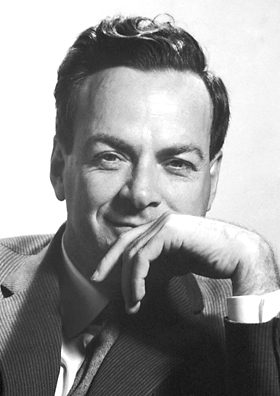| Line 2: | Line 2: | ||
=Introduction= | =Introduction= | ||
| − | + | When solving an integration problem in calculus, you may come across some complex problems where, when you try to solve the integration with various methods like "integration by parts," "powers of sine and cosine," "U-substitution," "trigonometric substitution," "rational functions," and "numerical integration" and still not get the desired answer and end up over-complicating the integral. To make life a bit simpler for such integrals, we can use "Feynman Integrals" which is a technique focusing on setting a function similar to the integral and then differentiating that function under the integral sign. This method of integration is also known as "Leibniz' Integral Rule". | |
<center>[[Image:Richard_Feynman.jpeg]]</center> | <center>[[Image:Richard_Feynman.jpeg]]</center> | ||
| − | Richard Philip Feynman, an American theoretical physicist, is known for this integration technique along with his other works in the theory of quantum electrodynamics, path integral formulation of quantum mechanics, the physics of the superfluidity of supercooled liquid helium, and in particle physics for which he proposed the parton model. | + | Richard Philip Feynman, an American theoretical physicist, is known for this integration technique along with his other works in the theory of quantum electrodynamics, path integral formulation of quantum mechanics, the physics of the superfluidity of supercooled liquid helium, and in particle physics for which he proposed the parton model. His technique to solve integrals by using differentiation under the integral sign helps to find the derivative on the nth order of the product of two functions to be expressed with a formula's help. |
[[ Walther MA271 Fall2020 topic14 | Back to Feynman Integrals]] | [[ Walther MA271 Fall2020 topic14 | Back to Feynman Integrals]] | ||
[[Category:MA271Fall2020Walther]] | [[Category:MA271Fall2020Walther]] | ||
Latest revision as of 02:06, 3 December 2020
Introduction
When solving an integration problem in calculus, you may come across some complex problems where, when you try to solve the integration with various methods like "integration by parts," "powers of sine and cosine," "U-substitution," "trigonometric substitution," "rational functions," and "numerical integration" and still not get the desired answer and end up over-complicating the integral. To make life a bit simpler for such integrals, we can use "Feynman Integrals" which is a technique focusing on setting a function similar to the integral and then differentiating that function under the integral sign. This method of integration is also known as "Leibniz' Integral Rule".

Richard Philip Feynman, an American theoretical physicist, is known for this integration technique along with his other works in the theory of quantum electrodynamics, path integral formulation of quantum mechanics, the physics of the superfluidity of supercooled liquid helium, and in particle physics for which he proposed the parton model. His technique to solve integrals by using differentiation under the integral sign helps to find the derivative on the nth order of the product of two functions to be expressed with a formula's help.

